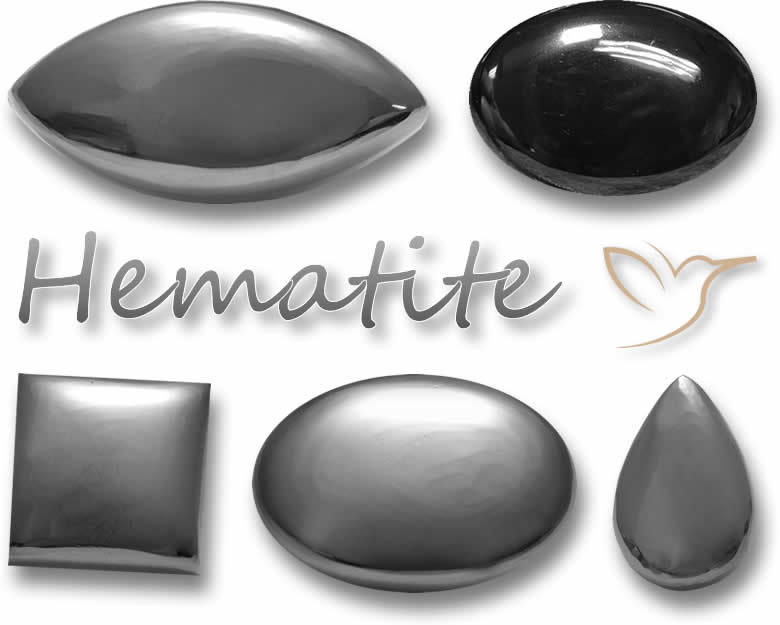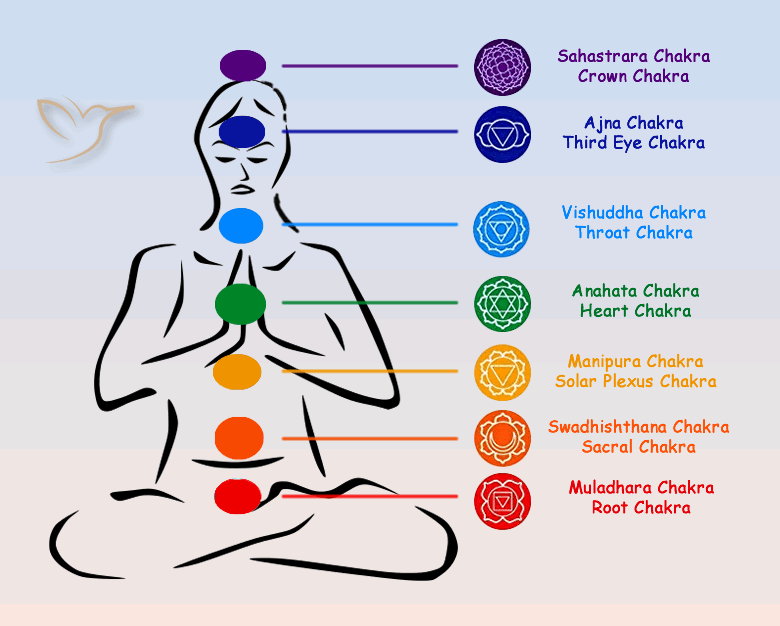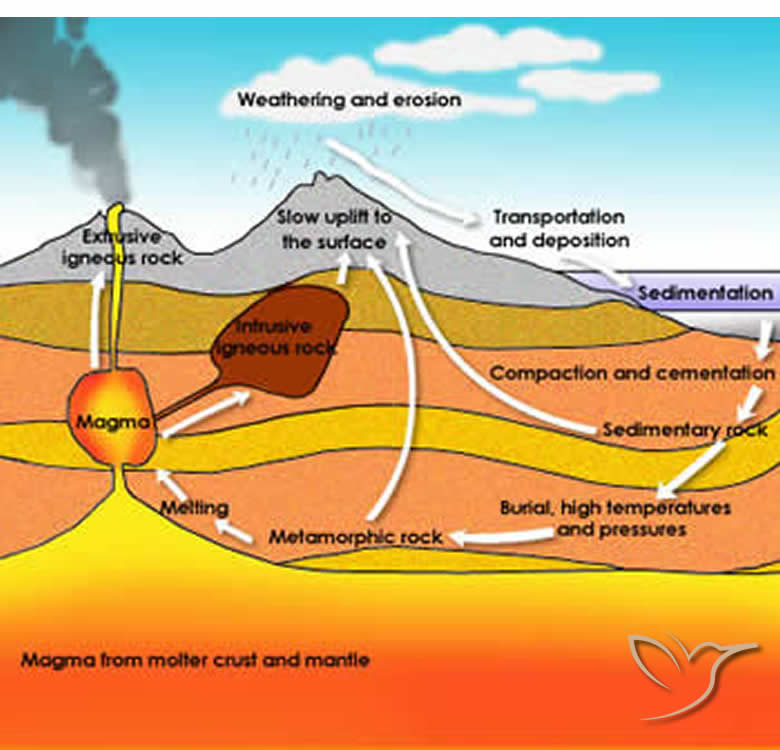Hematite Gemstone Information

Introduction
Writing about the importance of the mineral hematite could take weeks if I included its use as a coloring in lipstick, blush, and mascara, as well as oil paints, industrial undercoats, and bricks and cements.
Even longer if I had to discuss the iron and steel products that probably helped make the car you drove today and the houses and buildings you live and work in.
Luckily, I'm focusing on hematite as a gemstone. It might look a bit dull and rock-like when dug from the ground, but when cut and polished, it reveals a wonderfully smooth and shiny metallic finish. Plus, its high iron content gives this gemstone a real 'heft' or weight when you hold it in your hand. Since it's available in quite large sizes, you'll know you own something substantial when you buy one.
Hematite Colors

Hematite gemstones are generally silvery gray to almost black with a nice shiny polish and a smooth surface.
There are some examples with reddish streaks on a dark background and a very rare version which has an iridescent or rainbow sheen on the surface. The rainbow hematite is commonly simulated, so be wary.
Hematite gemstones do not look very impressive when freshly mined (not many gemstones do) - just a craggy looking piece of rock, usually gray but sometimes with a reddish-brown or brownish-yellow tinge. However, a bit of cutting and polishing reveals a mirror-like metallic silver or dark gray finish.
It's a mysterious gemstone because although it looks almost like a piece of silver when polished, it will still leave a reddish streak - caused by the iron oxide in the gemstone - if rubbed on glass or ceramics. And it will create red dust if ground into powder.
Hematite Species
Hematite is an iron oxide mineral which is technically made up of 70% iron and 30% oxygen (though rarely found that pure). Its usual appearance is a silver to dark gray, smooth gemstone cut into variously shaped cabochons and very rarely faceted.
There are a few varieties of this gemstone, but only a couple really worth mentioning:
- Rainbow Hematite
- Rainbow hematite is a multi-colored iridescent variety caused by a thin natural coating of an as-yet unidentified aluminum phosphate. The natural version is very rare, but the man-made type can be seen in many gift or novelty stores.
- Specularite
- Specularite is a hematite aggregate containing mirror-like flakes and layers. Learn more about its unique properties in our Hematite and Pyrite guide.
- Kidney Ore
- Kidney ore is a botryoidal variety which resembles a human kidney. Botryoidal means grape-like.
- Iron Rose
- Iron rose are flakes of hematite arranged in clusters making it resemble the petals of a rose.
There is a well-known variety called magnetic hematite; however, this is not, in fact, a hematite gemstone at all.
Hematite Clarity and Cut

Gemstones can be transparent, translucent, or opaque and can vary between these designations.
Hematite is an opaque gemstone, meaning no light can penetrate the surface even at the edges when held up to a light source.
Being opaque, hematite is rarely faceted and usually cut and polished into smooth cabochons. They can be cut into a variety of outlines - round, oval, pear, marquise, squares, just about any shape - and can also be engraved or carved into attractive animals, skulls, Buddhas, and so on.
Spiritual Meaning of Hematite
Disclaimer: The information provided on the spiritual meaning and health benefits of hematite is for informational purposes only and is not intended as a substitute for professional medical advice, diagnosis, or treatment. Always seek the advice of your physician or other qualified health provider with any questions you may have regarding a medical condition or spiritual practice.
When writing about gemstones, I often discover with amazement how long they have been used by and associated with mankind - pearl necklaces 8000 years old, turquoise in Tutankhamen's burial chamber, lapis lazuli and carnelian used in the 4000-year-old ancient kingdom of Sumer.
Those ancient people recognized the spiritual power and protection provided by these gemstones, but the use of the iron oxide which makes up hematite stretches back at least thirty or forty thousand years.
The cave paintings depicting bison and horses were created using ground-up hematite - known as ochre. This ochre powder has also been found at burial sites, used as war paint, mined in Australia continuously for 30,000 years, and used in paint-making kits for perhaps 100,000 years.
This was not just decorative and easy to find; early man recognized the spiritual strength of the iron oxide contained in both the hematite and the ochre.
Hematite is known as a grounding gemstone, giving you the focus to tackle day-to-day life as well as any challenges that may come your way. It gives you confidence in your abilities, allowing you to make decisions quickly, firmly, and objectively.
It will provide courage and protection when times are tough and bring positivity when everything seems lost. Balance, harmony, and awareness are just a few more of this amazing gemstone's attributes.
Hematite and the Chakras

As a gemstone with a mineral content high in iron and an internal color of red, despite its silvery appearance, hematite is very much linked with the Root Chakra.
The chakras are seven points located within the body which control a specific physical, mental, or emotional condition. According to the Hindu philosophy which developed the chakra system, the chakras are the Crown, Third Eye, Throat, Heart, Solar Plexus, Sacral, and Root. Each chakra corresponds to a color of influence, and a gemstone which has a particularly dominant color will often be associated with that color's chakra point.
Each chakra point is assigned a color: red for the Root Chakra, orange for the Sacral, yellow for the Solar Plexus, green for the Heart, blue for the Throat, indigo for the Third Eye, and purple for the Crown Chakra.
Sometimes our chakras get out of alignment or blocked and need to be realigned or cleansed. If you are feeling insecure about your home, employment, or relationship, it could be a sign that your Root Chakra is blocked, and hematite is the ideal answer.
Meditating with a hematite gemstone by your side or lying down with one placed either in the small of your back or on your lower belly will allow this gemstone to do its work.
Health Benefits of Hematite
Hematite's name will give a big clue as to its health benefits. Hema or haema comes from the Greek word for blood, and this is where hematite is so effective. Blood detoxification, circulation, high blood pressure, anemia, kidney problems, and PMS can all be treated with hematite.
As a gemstone connected to the Root Chakra, hematite can also alleviate the symptoms of a bad back and poor digestion.
We're certainly not experts in this field, but we've gained some experience and knowledge from our years of buying and selling spiritually powerful gemstones. Feedback from many of our customers has given us a few ideas of how they may best be incorporated into your health regime.
Of course, wearing a gemstone as a piece of jewelry is the easiest way for the crystal to influence your body, and putting one in your handbag or pocket where it can be easily used as a touchstone is a good alternative.
Meditating with a gemstone nearby can be beneficial, but it is not recommended to use hematite in the bath like you can with other types of gemstones. For optimal benefits, lie down with the gemstone placed on or near the point of pain or on the relevant chakra point.
It's important to note that magnetic hematite is different from real hematite. If you have a pacemaker, it is advisable to avoid magnetic hematite as a precautionary measure.
To cleanse a hematite gemstone, it is best to avoid water - it will not be affected by a quick rinse under fresh water so long as you dry it quickly, but water and iron are not good bedfellows. Definitely not salt water. Easiest, I think, is to just 'smudge' them by lighting incense and allowing the smoke to pass over it.
Hematite Price

Hematite Price List |
||
| Color | Size range | Price range / USD |
|---|---|---|
|
Multicolor |
Free Size |
$0.8 - 3/ct |
Hematite is generally an inexpensive gemstone and quite readily available. Hematite with a nice smooth polished luster and even gray color with a mirror finish is the most popular. The darkness of the gray is a matter more of personal taste than indicative of value - some prefer the almost black version and others prefer the silvery hues.
There is a rainbow hematite gemstone available which, if completely natural and genuine, can reach a premium price, and some forms have a nice rich red streak which can also fetch a good price.
All in all, this is a very affordable gemstone with some interesting features, curious shapes, and large sizes available. Whether it is to be added to a gemstone collection or incorporated into some imaginative jewelry, you cannot go wrong with a hematite.
Hematite Discovery and History

Mineral hematite has been used as a paint pigment or as a form of chalk for perhaps 200,000 years, even by modern man's ancestors, the Neanderthals and Denisovans! As a cut and polished gemstone, things are a bit more recent.
It is a relatively soft gemstone, so it could be carved into amulets and cylinder seals, which is exactly what the ancient Sumerians did in Mesopotamia around 3000 years ago. Ancient Egyptians thought hematite could staunch bleeding, so warriors took them into battle, and hematite talismans have been found in their tombs.
The ancient Greeks gave this stone its present name, which began as 'haimatites lithos' meaning blood red stone. The ancient Romans associated hematite with the god of war, Mars, and in fact, the planet Mars appears red because of the presence of iron oxide or hematite on its surface.
In more recent times, its subdued gray colors led it to be often used as mourning jewelry during the Victorian era in England.
Where is Hematite Found?

The mineral hematite is found all over the world and most often used as a source of iron ore, but hematite gemstone sources are a bit scarcer. Brazil produces a lot of fine quality gemstones, as does Morocco, South Africa, and many locations in the USA.
Cumbria in England provides the world with the specularite variety, and the island of Elba in Italy is a classic source of this gemstone.
How is Hematite Formed?

The story of hematite's formation is one of the most fascinating of all gemstones. It begins 2 or 3 billion years ago with the appearance of sea-dwelling cyanobacteria, a simple single-celled organism, which literally changed the world.
Before they came along, there was not a lot of oxygen in the planet's atmosphere, but through the process of photosynthesis (remember that from school?), these cyanobacteria released tons of oxygen from their habitat on the shallow ocean floor.
This oxygen bubbling up through the water bonded with the dissolved ferrous iron which filled the seas at the time and sank to the bottom. This formed layer after layer of banded iron, and since it continued for a billion years, there is a lot of iron around!
Later movements of the earth's plates, hydrothermal activity, volcanic eruptions, ground water reaction, heat, and pressure , and brought them from the bottom of oceans to the land and mountains where man could reach them.
By the way, the oxygen that was released by the cyanobacteria which did not bond with the iron oxide emerged from the seas, changing the climate, making the air breathable, and leading the way for animals and plants to evolve.
Can Hematite Be Treated?
Hematite gemstones are not generally treated in any way other than the usual cutting and polishing of the rough material.
Some gemstones labeled hematite are treated, for example, magnetic hematite and rainbow hematite, but magnetic hematite is not hematite, and rainbow hematite is often fake.
What Jewelry is Hematite Suitable For?
Hematite is rated around 5.5 to 6.5 on the Mohs hardness scale, so it is durable enough for most types of jewelry, although rings and bracelets may need more protective settings and more care when being worn.
The large sizes and heavy feel of this particular gemstone lend itself to being used as a pendant; its eye-catching silvery shine and unusual luster make it popular for contemporary or bohemian styles.
It is spiritually powerful, so it may not be such a good idea to wear this as an item of jewelry for too long or when you go to sleep.
How to Care for Hematite
Hematite is sort of in the middle where durability is concerned, so it should be stored in individual bags to keep it from being scratched by harder gemstones such as quartz or from scratching other softer gemstones.
Do not use solvents or harsh chemicals to clean hematite; just warm soapy water will suffice.
Take off any hematite jewelry if partaking in any sporting activity or housework and gardening.
How to Tell a Real Hematite

Getting a certified gemstone from a reputable and long-standing dealer is the best guarantee of getting a real gemstone, but this is not always straightforward when you are searching the internet or gem stores for a gemstone.
Hematite is a silver to dark gray metallic-looking gemstone. Take a look at some genuine versions on the internet or in a trustworthy gems store to familiarize yourself with what they are supposed to look like.
If you can hold a hematite gemstone, it will feel quite substantial and 'hefty', heavier than you might suspect when you first see one. It will also initially feel quite cool to the touch until it has time to warm up through the heat of your hand.
Real hematite gemstones are not magnetic (at least not strongly magnetic). If they are 'attracted' to each other or to something metal, then they are not real.
Another test for real hematite is to give it a quick rub with sandpaper. The hematite should be a bit red below the surface or the powdered hematite should be reddish in a real gemstone.
The same idea works with a streak test. Scrape a piece of hematite across some unglazed porcelain or some black sandpaper, and it should leave a red or brown streak.
These are both somewhat destructive (as is the smashing with a hammer or grinding up techniques), so only do with the permission of the owner.
Keep an eye out for some rather dubious names including hemalyke, hemalike, hematine, as these are not real or natural hematite gemstones.
This has not been a comprehensive guide on how to make sure your hematite gemstone is completely genuine, but I hope it helps.
At GemSelect, we currently offer brief identification reports from your choice of three well-respected independent gemological laboratories: American International GemLab (AIG), International Colored Gemstone Association Laboratory (ICA GemLab), and Burapha Gemological Laboratory (BGL Lab).
Can Hematite Change Color?

Some gemstones show a distinct or dramatic change in color depending on the light source. Look at some varieties of garnet under artificial or electric light, and they could look red; take them outside into the daylight, and suddenly they are green! This does not occur in hematite gemstones.
What is So Special About Hematite?
Hematite is a remarkable material; it is what makes so many soils look that deep rich brown that seems so fertile, makes Australia's red center so red, and makes the planet Mars the Red Planet. Despite all this, when it is polished up, it becomes an almost mirror-like metallic silver gemstone!
As jewelry, it can be carved or shaped into fascinating primeval-looking pendants or iconic archaic-looking rings, and as collectors' pieces, they can really set off a display case or board.
For those with spiritual beliefs, this gemstone ticks a number of boxes from grounding to encouraging and will always be beneficial to its keeper.
Hematite - Gemological Properties
|
Chemical Formula: |
Fe2O3, Iron oxide |
|
Crystal Structure: |
Trigonal - mostly platy |
|
Color: |
Black, black-gray, brown-red |
|
Hardness: |
5.5 to 6.5 on the Mohs scale |
|
Refractive Index: |
2.940 to 3.220 |
|
Density: |
5.12 to 5.28 |
|
Cleavage: |
None |
|
Transparency: |
Opaque |
|
Double Refraction or Birefringence: |
-0.287 |
|
Luster: |
Metallic; iron |
|
Fluorescence: |
None |
Frequently Asked Questions
What colors does hematite come in?
Hematite gemstones are typically silvery gray to almost black with a shiny polish. Some have reddish streaks, and rare versions show an iridescent rainbow sheen, though these are often imitated.
What is the spiritual meaning of hematite?
Hematite is considered a grounding stone that provides focus, confidence, courage, protection, and positivity. It promotes balance and harmony. Remember, these are based on traditional beliefs and not scientifically proven.
What are the health benefits of hematite?
Traditionally, hematite is associated with blood-related issues like circulation, anemia, and kidney problems, as well as back pain and digestion. These claims are anecdotal and should not replace medical advice.
How can I tell if hematite is real?
Real hematite feels heavy and cool, isn't strongly magnetic, and leaves a red streak when scraped on unglazed porcelain. Avoid names like hemalyke or hematine, which are synthetic.
Where is hematite found?
Gem-quality hematite comes from Brazil, Morocco, South Africa, the USA, England's Cumbria (for specularite), and Italy's Elba Island.
How much does hematite cost?
Hematite is affordable, usually $0.8 to $3 per carat for multicolor free sizes. Natural rainbow varieties can be pricier if genuine.
Can hematite be used in jewelry?
Yes, it's suitable for most jewelry, especially pendants, but use protective settings for rings and bracelets due to its moderate hardness. Avoid wearing it constantly if you believe in its spiritual power.

